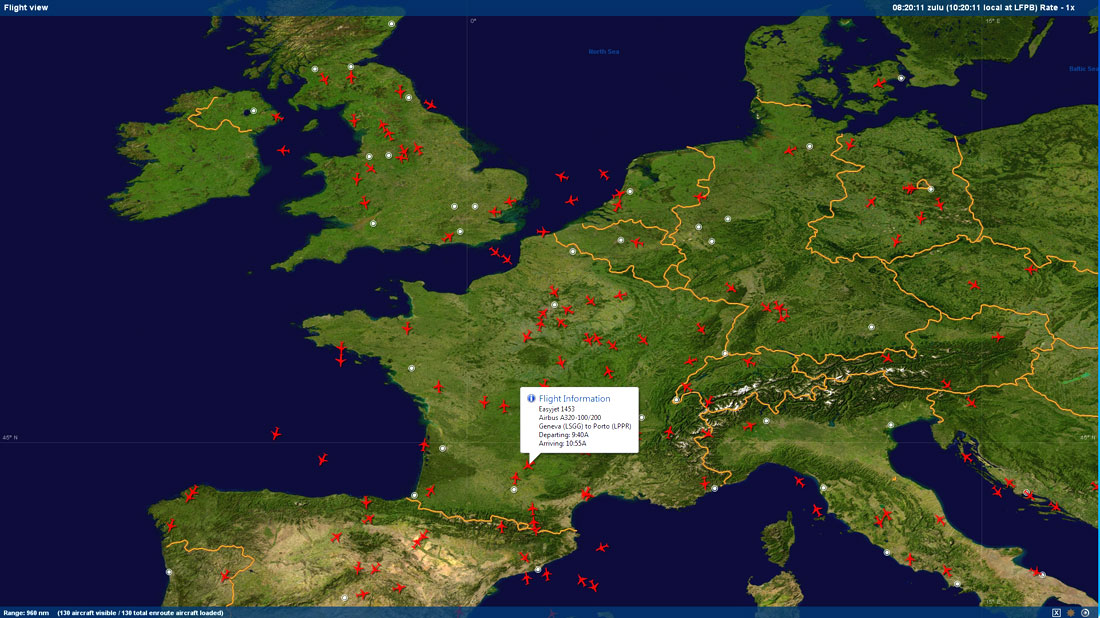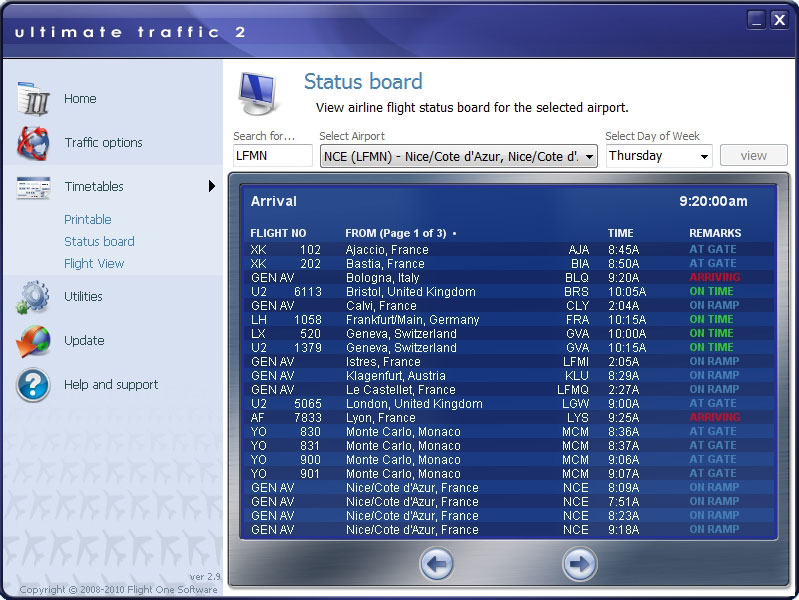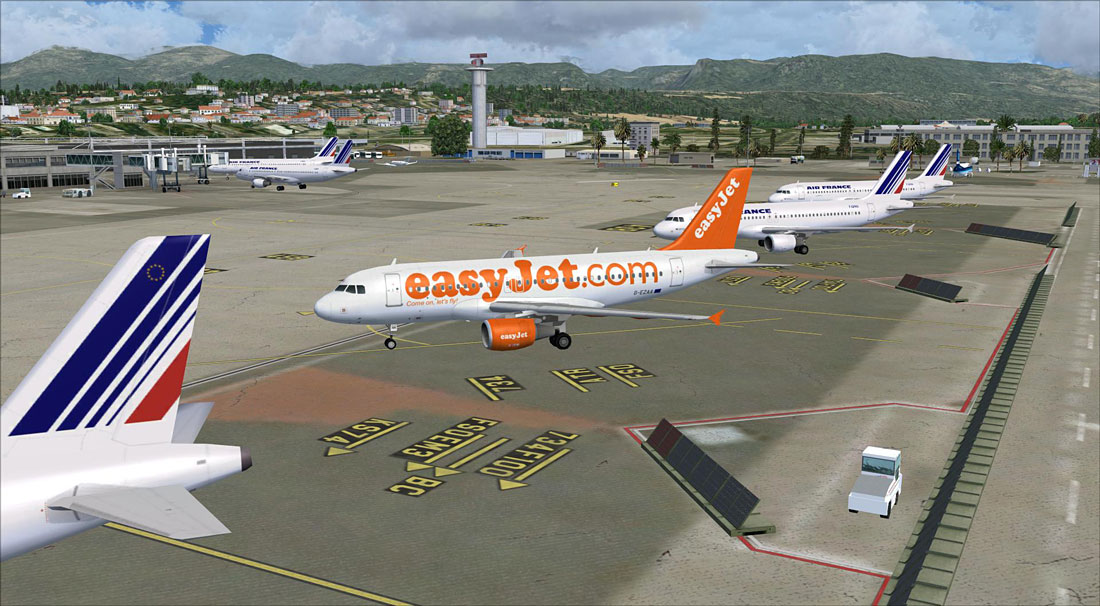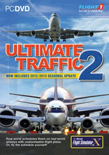Mutley's Hangar
A Haven For Flight Simulation Enthusiasts!

Ultimate Traffic 2 - 2013 Edition
For FSX Published by Flight1
Reviewed by Joe Lawford
May 2013
Background
Ultimate Traffic 2 (UT2) has been around for a long time and is one of the
best selling FSX add-ons. This latest release on DVD is not a new program, rather the
latest version (2.09) along with the 2012 /2013 seasonal update. This release of the
program on DVD will please a lot of flight simmers who like to have the security of a
DVD backup and another colourful box on their shelf!
For me, UT2 has always been a reference product that others aspire to, it's always one
of the first products I reinstall into a new FSX installation.
So what makes UT2 so popular? It's worth listing the features from the developer to
remind ourselves what we are getting for our $45.
Up-to-date Seasonal Schedule - Included on the same disc is the simple
to install update to the schedules, the latest real-world schedule available at the
time of publishing.
550,000+ Real-Time Schedules Flights - UT2 provides AI traffic for
over 550,000+ scheduled flights based on airline timetables. These schedules include
international, national. regional, commuter and air cargo operators.
1,300,000+ General Aviation Flights - Besides commercial schedule
flights, UT2 will provide 1.3 million general aviation flights. These flights fly
between 6,400 airports and log over 2.5 million flight hours each week.
100's of Airlines Worldwide - UT2 contains over 1600 aircraft repaints
of various worldwide carriers both big and small with over 90 aircraft types.
6000+ Airports with Traffic - AI traffic for over 6000 airports
providing an active airport environment.
Fully Featured Interface - The interface controls all aspects of the
program detailed below.
Add-On Schedules - Create and manage custom add-on schedules. Complete
virtual airline schedules can be created using UT2's own proprietary tools.
Airline / Airport printable timetables - Organise and print timetables
for any airline or by airport that resemble timetables which can be found at your local
airport for your favourite airline.
Flight Plan Assignments - Each airline flight uses a flight plan to
navigate to its destination airport, these flight plans can be customised. Flight plans
can be created using FSX or third-party utilities and assigned to UT2.
Flight View Map - Create maps views of anywhere on the planet and view
all all the traffic flying in that area.
 Flight View Map |
 Electronic Status Board |
Status Board - View a live status board for any airport that handles commercial aircraft in UT2. Departures and arrivals can be viewed to check movements. Ideal if you are spotting.
Airline / Tail numbers - Each airline can have its own rule for generating tail numbers, Ultimate Traffic uses these rules to generate tail numbers for each flight in the database. Users can also manage and assign parking codes to any FSX aircraft.
VoxATC and Ideal Flight compatible - UT2models can be used in these 3rd party programs.
Installation & Spec
The DVD installation is straight forward enough with only confirmation of the installation path needed.
With all these aircraft and liveries, the new aircraft alone will take up 2.82Gb of space and 5.15Gb for the whole shebang! It is also worth noting that the 2013 update will be looking for another 1.61 Gb. Looking in my AppData folder it is showing 3.87Gb with the updated schedule table and a back up of the old schedule, so that takes it to whopping 6.69Gb!
Minimum system requirements are very low, 2.8 GHz processor, 256 Mb graphics and 1Gb of memory. It's good to know that this should run well on any current computer.
Using Ultimate Traffic 2
FSX - An entry gets added to your flght sim's exe.xml file which instructs your PC to start the Ultimate Traffic 2 program when FSX starts, so the program is always ready to go.

When FSX starts you get a message "Ultimate Traffic 2 is initialised" This made me jump the first time but at least I knew it was working. Thankfully this message can be switched off in the interface/Utilities/In game options page so no more tea spilt on the keyboard!
The main difference between UT2 and other traffic programs is that it doesn't generate a traffic.bgl file like the others do. In fact, you can turn your FSX traffic controls to zero as UT2's airline and GA traffic levels are controlled from within the interface and will override any setting in FSX. The traffic is injected directly by the SimConnect interface.
One major benefit that UT2 has over the others is that it will only inject aircraft that are needed in that area according to its schedules, so it should be as real as it gets. The problem with default and other traffic programs is they use bgl files which use a lot of FSX system resource and over-clutter airports in an unrealistic way. Also, more than one aircraft could be flying the same route at the same time. How many times have you gone AI spotting in FSX and found two airliners flying in formation at 35,000 ft! This shouldn't happen with UT2, what you will get will be less congestion.
 Ground Traffic at Sydney (Note, Q400 is not AI in this shot) |
On the Ultimate Traffic forum, John Goodwin has posted an excellent insight into the workings of UT2, and I quote..
"It takes time for the flights to get going, up to 10 minutes for traffic to start moving on the ground and about 15 minutes for traffic to start landing. The reason for the delay is the way FSX handles the departures and arrivals. Dealing with arrivals first. If you start an FSX flight at 12:00 local any flights that are due to land between 12:00 and about 12:10 will spawn on the ground at a gate in the sleep mode. Any flights due to land after 12:10 will spawn flying towards their destination airport and land as normal, but this takes time so do not expect to see landing aircraft for up to 15 minutes after starting you flight.
Departing aircraft are handled a bit differently aircraft that were due to depart up to the time you start your flight will usually spawn in the air, an aircraft that was due to depart 5 minutes after you start your flight will usually depart LATE due to the way FSX handles departures.
A couple of factors affect the way flights start in FSX and what you see happening:-
● If you have your ground support vehicles (airport traffic GSV) turned on or off
● The number of refuelling trucks you have at an airport (dependent of GSV being on or off)
● The type of parking space the aircraft is parked at either a GATE or CARGO/GA RAMP
First let me explain the sequence of modes a departing flight goes through when parked at a GATE with GSV (General Service Vehicles) turned on and FSX having been running for about 15 to 20 minutes.
● About 20 minutes before departure the aircraft becomes ACTIVE, if you use MS FSK SDK Traffic Tools you will see that the flight number for
the next flight appears next to the aircraft but the aircraft stays in SLEEP MODE
● About 15 minutes before departure the aircraft moves in to the PRE-FLIGHT MODE, GSV will move into position around the aircraft and
a fuel truck will arrive and re-fuel the aircraft.
● After the fuel truck has left AND about 10 minutes after the GSV vehicles are positioned around the aircraft, the GSV vehicles will start to
move away from the aircraft and the aircraft will enter the CLEARANCE MODE were it requests clearance for it’s flight from ATC.
● After receiving it’s clearance the aircraft will PUSH BACK and request TAXI and eventually enter the TAXI-OUT mode."
A nice feature with UT2 is if you are on final and there is an AI aircraft slow to vacate the runway you can use a menu option or a keyboard shortcut to clear approach, this can save you a lot of time as there is nothing worse than having to perform a go around after a long flight. On the same menu you can also stop and start the traffic at will.
 Liveries at Nice LFMN |
 Remote AI |
 AI Landing |
 Remote AI 2 |
You will also notice that the AI models are of very high quality, most of them are copyright of AI Aardvark
The Interface
The interface is of a set up tool and doesn't have to be run every time you want to fly. FSX will automatically start the UT Service which provides the data to the sim. You will be able to set it up and forget about the interface until you feel it is time to check for an update or have a tinker.
Home

|
On the home page, the Traffic Statistics put all that programming into perspective - ^Just take a look at those numbers!^
Airport Operations - Here we can see the statistics for our chosen airport Nice Cote d'Azur LFMN (NCE) for our chosen day, Sunday. This would be the same of any week of the year with the current schedule loaded. The blue bars designate departures and red bars designate the arrivals.
Traffic options
We can set our desired traffic density and choose to disable GA or Airline traffic separately. If UT2 should devise a combination of aircraft and airline it has no livery for then it will use a fallback livery of a fictitious airline "Daedalus, see below. There is nothing to stop you substituting these repaints for one of your own or for your favourite airline so you would see them everywhere.
 Default Airline "Daedalus" |
FSX has moving jetways at some piers, you can disable them docking with UT aircraft to save more system resource.
Aircraft Repaints - In this section we can select any of our FSX aircraft / livery and assign it to a UT2 aircraft so if you have, say, an iFly 737 in a new livery you could get it to show in UT2. The only drawback is with complex aircraft come performance implications. You can go on to enable/disable individual airlines and sub traffic using Database Management.
Flight Options - You can search for a particular flight, there are useful filter options for arrival airport, airline and carrier. The output tells you the time, aircraft type and at what density setting it will start to appear.
 View UT2 Flight |
 Convert to FSX Flight Plan |
One nice touch is the "Fly Flight" which fires up a new window with the flight plan, you can create an FSX flight plane from here and fly it in the sim. Beware though, if you have replacement scenery you may not be placed where you expected to be. Also, as with any flight plan, you will need to select your aircraft, weather and time of day.
AI Labels - Here you can set the time that contrails remain on the screen, remember, if you have a lot of traffic setting this high could affect performance. There are also label options similar to FSX but with more detail.
Timetables
Utilities
Tail Numbers - Each airline can have a specific set of rules for creating a unique tail number. Numbers are then randomly generated by the rules for each flight in the database.
Flight Plans - Unlike other traffic programs, UT2 actually flies its commercial airline traffic on real flight plans. No longer do airlines fly directly between 2 airports, rather they are flown on flight planned routes that follow the High and Low Altitude routes around the Earth. Even aircraft crossing the Atlantic Ocean will follow the routes known as NATS tracks. Using the Flight Plan Assignments page, you can change the routes on any UT2 commercial aircraft if you desire. This is done by importing a pln file used in FSX for its routing.
In Game Settings - Keyboard shortcuts can be defined here incase you already have the default UT2 shortcuts assigned to another feature. Next, and more importantly there are four sliders that control maximum frame rate and the spawning of aircraft by height, distance and the maximum number of flights to create.
Parking codes - All aircraft come assigned with a parking code. However, if you want to change or set a code for an imported aircraft, you can set that code here.
Update
Both the UT2 program files and schedule versions are checked here. Surprisingly it said my 2012 / 2013 schedule was out of date reporting it as version 7 when right underneath it told me I had version 8 installed. This may be because it was on disc rather than via a download, not a show-stopper but a minor bug all the same.
Help & Support
There is quite a variety of support, mostly offered through dedicated forums run by Flight 1. There is a lot of good info in there and links to the Ultimate Traffic microsite where other information is available and options to download the UT2 "Power pack". The Power Pack, they say is "An easy to use tool to compile and import add-on schedules" so there you have it!
 Arrivals |
When Ultimate Traffic 2 first starts and when it updates there is a very noticeable pause in the sim which, I must admit, on a couple of occasions I had thought I was heading for a sim crash, but fortunately that has never happened. Once the system has spawned the aircraft it is pretty smooth going from then on.
One annoying trait this program has is it seems to re-spawn aircraft if you go into any menu items like map, aircraft realism and other non-ai related items. If you had been spotting aircraft on the ground and had a good queue built up of departing aircraft, they will disappear and start again. Not being sure of the complexities of the program or SimConnect I am not sure if this is fixable.
Some of the aircraft movement on the ground can be a bit twitchy when taxiing but that seems to happen with AI when turning on the ground.
High traffic settings are a known frame rate killer, with a lot of the processing going on in Ultimate Traffic 2, FSX gets more system resource, so everyone should experience some relief here. I run the program set with 100 density aircraft in the UT2 interface and I can't see any performance hit.
Conclusion
Ultimate Traffic 2 is a humble little program running in the background but giving excellent results. The traffic generation is still unique amongst traffic utilities and very sim friendly. Because of the timetable system you will only get relevant traffic to that airport at the time it should be there.
The only downside for me is the delay when UT2 updates the sim, and re-spawns aircraft after looking at unrelated menu items, but it isn't a show-stopper.
Even after all these years UT2 still remains for me, the best traffic program you can buy. I have read comments of "When will the next version be coming out?" It's difficult to know what you could change. The interface should exceed the requirements of most simmers, in fact, you need not bother with it at all if it's not in your nature to tinker.
So, if you haven't got Ultimate Traffic 2 yet, why not!?
Verdict
|
• Ease of Use: • Features: • Performance: • Documentation: • Value for money: |
9.0/10 9.0/10 9.0/10 9.0/10 9.0/10 |
 |

Mutley's Hangar score of 9/10
Review machine Spec: Core i7 Extreme 965 @ 3.6 Ghz | 16Gb Corsair DDR3 Ram |GTX690 Graphics |Windows 7 64bit
|
|
